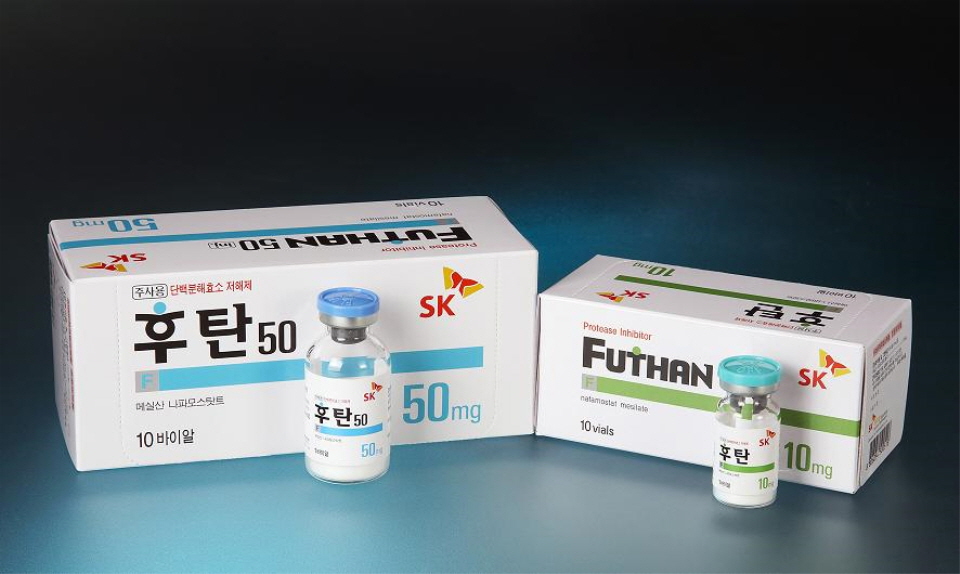● SK chemicals’ ”Injectable Futhan” Marks its 14th Sales Anniversary
- SK chemicals’ “Injectable Futhan” boasts its short half-life as one of its best advantages... It also contributes to improvements in safety for dialysis patients.
- Usage is expected to expand to extracorporeal blood circulation in conjunction with artificial kidneys, artificial heart, or artificial lungsSK chemicals’ “Injectable Futhan,” an anticoagulant for extracorporeal circulation, has marked its 14th sales anniversary.
SK chemicals (CEO Jeon Gwang-Hyeon) stated on the 19th that the anticoagulant Injectable Futhan (FUTHAN inj., chemical name: nafamostat mesilate), which was introduced to South Korea by the Japanese company Toria in 2005, marks its 14th year of domestic sales.
A total of 12.57 million bottles of SK chemicals’ Injectable Futhan have been sold during the past 14 years. By hitting a sales record of ten billion won per year for the last ten years, FUTHAN has made its place as one of the company’s popular products.
SK chemicals’ Futhan has demonstrated sufficient anticoagulative effects outside the body during dialysis without increasing bleeding in patients prone to bleeding in the multi-center clinical trial conducted during the product’s release in South Korea.
SK chemical’s Futhan shows its greatest advantage in its extremely short half-life, at 5-8 minutes. It demonstrates anticoagulant effects only in the necessary filters and dialysis machines without affecting the entire body. Injectable Futhan is undetectable in the body 15 minutes after administration.
The standard coagulant heparin is made with the substance purified from extracts of pig organs. The half-life of heparin is one hour and thirty minutes (0.7-2.5 hours) and may be longer depending on the dose administered. It poses the risk of bleeding in other body parts if the anticoagulant effect remains in the body after the completion of extracorporeal blood circulation.
Critical patients, in particular, need more attention with regards to bleeding. The short half-life of Futhan is a significant advantage in this condition.
SK chemicals’ Futhan has been widely used as an anticoagulant in CRRT1 (Continuous Renal replacement therapy) to support the kidney functions of critical patients.
Since September 2019, it has become available for dialysis patients including those who will receive/have received surgery, as well as those with bleeding conditions or low platelet counts. In addition, the standards of administration of Futhan have been expanded to support abnormal cardiovascular functioning through extracorporeal blood circulation during the use of ECMO2, the extra-corporeal membrane oxygenator.
According to the yearly report by the Japanese Dialysis Association, the rate of death of dialysis patients due to excessive bleeding, which was 6.3% in 1986, decreased significantly since Injectable Futhan became available to a rate of 1.4% in 2015. Futhan has been evaluated in favor of its contribution to safe extracorporeal blood circulation.

* Photo attached: SK chemicals’ anticoagulant, Injectable Futhan
※ Glossary
1. CRRT (Continuous Renal Replacement therapy): a therapy that filters waste and water from the body in place of the kidney by circulating blood outside the body and returning the filtered blood back to the body. The therapy is slowly performed for 24 hours, in a similar fashion to real kidney functioning.
2. ECMO (Extra-corporeal membrane oxygenator): a device that has become widely known due to MERS. It circulates the blood outside of the body for elimination of carbon dioxide and oxygenation of the blood in place of the lungs and circulates the blood in the body in place of the heart. The therapy has been developed over the last 10 years to a point that it can completely take over the entire cardiovascular system and allow a patient to wait for a heart or lung transplant, compared to the past where it simply supported cardiovascular functions.